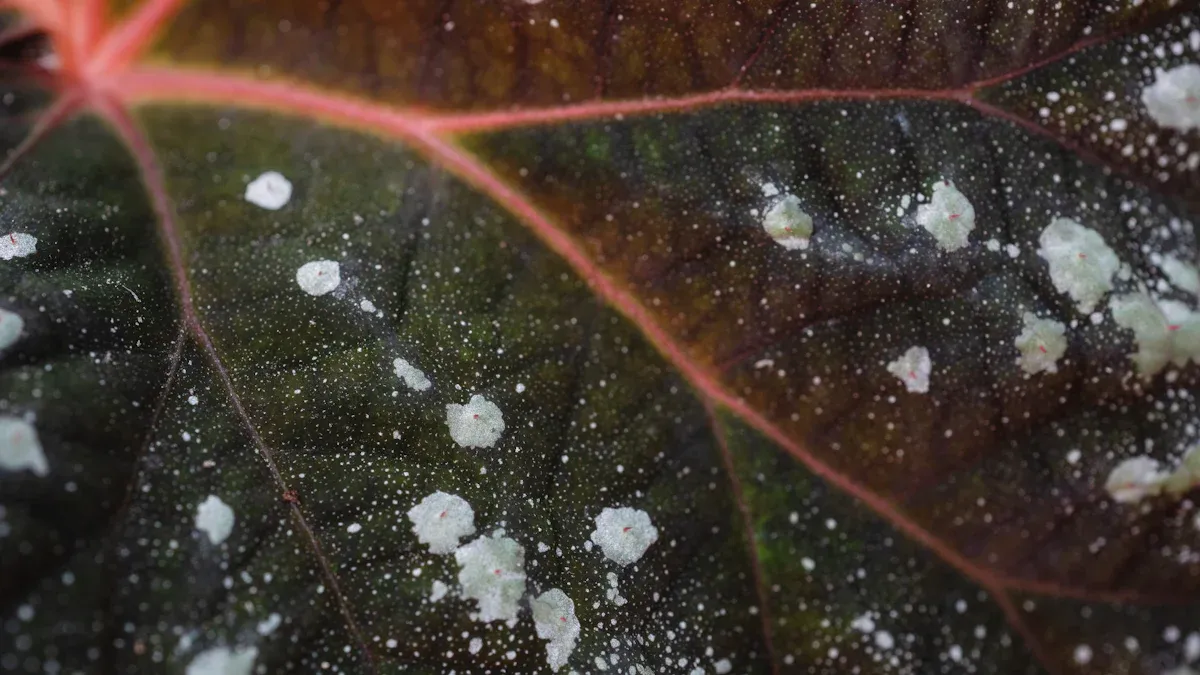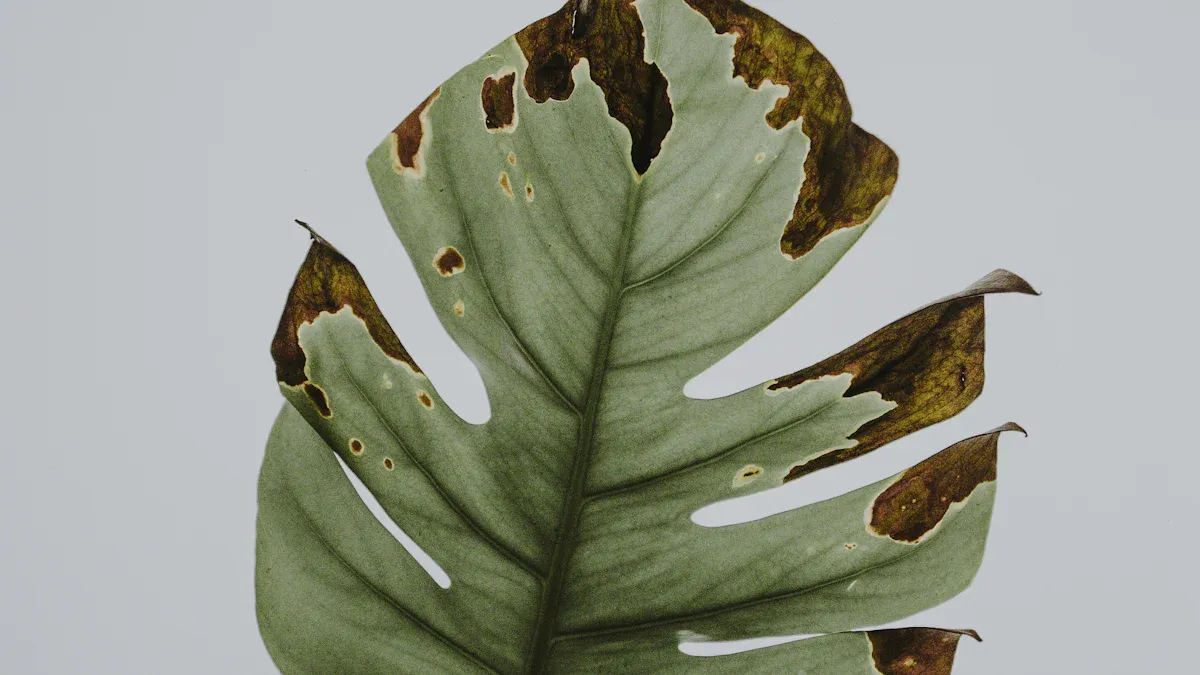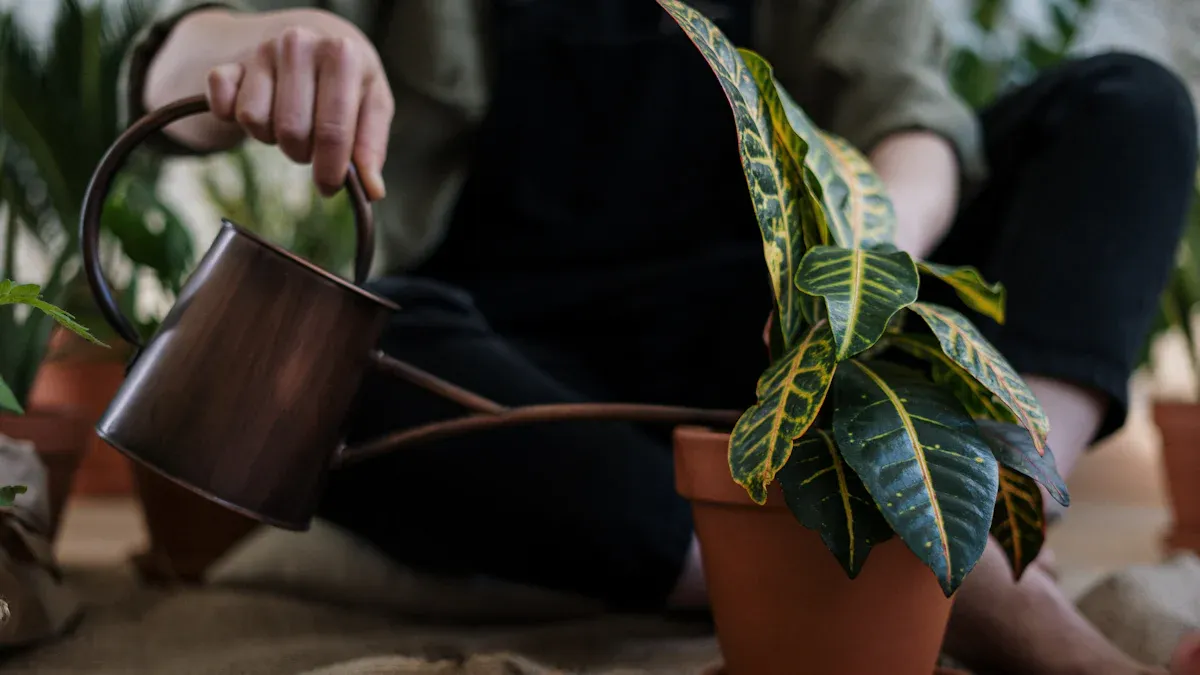
Identifying Birkin plant diseases is crucial for the overall health of your plants. Many plant owners worry about symptoms like yellowing leaves or brown spots. These signs can indicate issues that require attention. By learning to recognize these Birkin plant diseases early, you can take steps to ensure your plants thrive. Common concerns include:
Yellowing Leaves: Indicates overwatering.
Brown Leaves: Suggests low humidity or insufficient watering.
Stunted Growth: May point to insufficient light.
Understanding these symptoms helps you provide better philodendron Birkin plant care.
Key Takeaways
Identify symptoms early. Look for yellowing leaves, brown spots, and wilting. Recognizing these signs helps you take action before problems worsen.
Use proper watering techniques. Allow the soil to dry between waterings to prevent root rot. Check moisture levels regularly to keep your plant healthy.
Maintain ideal humidity and light. Keep your Birkin plant in bright, indirect sunlight and ensure high humidity. This environment supports healthy growth.
Regularly inspect your plants. Visual checks can help you catch diseases early. Look for signs like mushy stems or stunted growth to address issues promptly.
Implement preventive measures. Quarantine new plants, use well-draining soil, and practice regular maintenance to keep your Birkin thriving.
Common Diseases
Understanding the common diseases that affect your philodendron birkin is essential for maintaining its health. Early identification of these issues can save your plant from severe damage. Here are the primary types of diseases you may encounter:
Fungal Infections
Fungal infections are among the most common problems for philodendron birkin plants. They thrive in damp conditions and can quickly spread if not addressed. Here are some notable types of fungal infections:
Fungal Infection Type | Distinguishing Features | Treatment Methods |
|---|---|---|
Root Rot | Yellowing leaves, mushy crown or stems, unpleasant odor | Re-pot, trim affected tissue, use well-draining soil |
Fungal Leaf Rot | Dark, watersoaked lesions that become sunken and darken over time | Isolate affected plant, cut off affected leaves, treat with fungicide |
Fungal Blight | Masses of white mycelia on stems and leaves | Inspect plants, prune damaged leaves, maintain hygiene |
Bacterial Diseases
Bacterial diseases can also pose significant threats to your birkin. These infections often manifest through specific symptoms. Here’s a closer look:
Disease | Symptoms | Pathogen/Cause |
|---|---|---|
Bacterial Leaf Spot | Translucent spots on leaf margins become reddish-brown with yellow halos. Large spots are tan and irregularly shaped. | Xanthomonas campestris pv. dieffenbachiae |
Bacterial Blight | Small very dark green spots on leaves expand rapidly and spread to petioles. Infected leaves collapse in a wet rot that smells foul. | Erwinia caratovora pv. Carotovora E. chrysanthemi |
Viral Infections
Viral infections are less common but can be devastating. Symptoms often include mottled leaves or stunted growth. Unfortunately, there are no effective treatments for viral infections, so prevention is key. Always inspect new plants for signs of viruses before introducing them to your collection.
By recognizing these common diseases early, you can take action to protect your philodendron birkin. Regular monitoring and proper care will help keep your plants healthy and thriving.
Symptoms of Birkin Plant Diseases

Yellowing Leaves
When you notice yellow leaves on your philodendron birkin, it often signals a problem. This symptom can arise from various issues, including:
Overwatering: Excess moisture can suffocate roots, leading to root rot.
Nutrient Deficiency: A lack of essential nutrients, especially nitrogen, can cause leaves to yellow.
Poor Drainage: If your potting mix retains too much water, it can lead to yellowing leaves.
Identifying the cause early can help you take corrective action. For instance, if overwatering is the issue, adjusting your watering schedule can restore your plant’s health.
Brown Spots
Brown spots on your birkin leaves can be misleading. While they may indicate disease, they can also be normal features of the plant. Here are some key points to consider:
Users often report that brown spots appear on Birkin plants without indicating disease.
Some have treated their plants for fungus, only to find the spots persist, suggesting they may be normal.
Nectaries, which are small structures on leaves, can resemble disease symptoms but are not harmful.
Understanding these nuances helps you avoid unnecessary treatments. Always inspect your plant closely to determine if the brown spots are a sign of a more serious issue or just a natural characteristic.
Wilting and Drooping
Wilting and drooping leaves can be alarming. These symptoms often indicate that your philodendron birkin is stressed. Here are some common causes:
Inconsistent Watering: Irregular watering can lead to wilting. Check the soil moisture regularly.
Low Humidity: Birkin plants thrive in humid environments. Low humidity can cause leaves to droop.
Environmental Stress: Heat or cold-related stress can also lead to wilting. Ensure your plant is in a stable environment.
When your plant lacks water, its cells lose turgor pressure. This loss leads to wilting and a limp appearance. To prevent this, maintain consistent watering and monitor humidity levels.
By recognizing these symptoms early, you can take action to address any underlying issues. Regular observation and care will help your philodendron birkin thrive.
Identification Methods
Identifying birkin plant diseases early is crucial for effective care. You can use several methods to spot issues with your philodendron birkin. Here are three effective identification techniques:
Visual Inspection
Regular visual inspections help you catch problems before they worsen. Look for specific indicators that signal potential issues. The table below outlines some reliable visual indicators:
Indicator | Concern | Solution |
|---|---|---|
Yellowing Leaves | Indicates overwatering, leading to root rot. | Assess soil moisture, allow drying, and repot if necessary. |
Browning Leaves | Suggests inadequate humidity or insufficient watering. | Increase misting or use a humidifier; balance watering. |
Brown Leaf Edges | Indicates an environment too dry. | Use a pebble tray, humidifier, or mist regularly. |
Stunted Growth | Could indicate insufficient light or being root-bound. | Move closer to light; repot if root-bound. |
Mushy Stems | Caused by excessive watering and insufficient light. | Trim decaying sections, apply fungicide, and adjust watering and light conditions. |
By monitoring these signs, you can take proactive steps to maintain your plant’s health.
Soil Testing
Soil testing is another effective method for identifying issues. Testing can reveal harmful pathogens that affect your philodendron birkin. Common soil pathogens include:
Fusarium
Macrophomina
Phoma terrestris
Phytophthora
Pythium
Rhizoctonia
Sclerotinia
Sclerotium
Verticillium
You can send soil samples to a lab for analysis. This process helps you understand the health of your soil and identify any pathogens that may harm your plant.
Consulting Resources
Utilizing online resources can enhance your understanding of birkin plant diseases. Here are some recommended sites:
Plant Health Centre: A comprehensive resource for identifying plant diseases, including guides and management strategies.
CABI Field Guide: Useful for identifying damage on woody plants.
Plantwise Knowledge Bank: Offers detailed information on various disease-causing organisms.
Montana State University Plant Pathology Resources: Provides research-based information on plant diseases.
Forest Pathology: A valuable site for general information on tree diseases.
These resources can provide valuable insights and help you make informed decisions about your philodendron birkin care.
Treatment Options for Reviving a Philodendron Birkin

Reviving a philodendron birkin requires a thoughtful approach. You can choose from various treatment options based on the specific issues your plant faces. Here are some effective methods to consider:
Organic Remedies
Organic remedies can be a safe and effective way to treat diseases in your philodendron birkin. Here are some popular options:
Neem Oil: This natural pesticide helps control pests and fungal infections. Mix neem oil with water and spray it on affected areas.
Baking Soda Solution: Combine one tablespoon of baking soda with a gallon of water. This mixture can help combat fungal diseases when sprayed on leaves.
Diatomaceous Earth: This powder can deter pests like aphids and spider mites. Sprinkle it on the soil and around the plant to create a barrier.
Using these organic remedies can promote a healthier environment for your birkin while minimizing chemical exposure.
Chemical Treatments
Sometimes, you may need to resort to chemical treatments for severe infestations or infections. Here are some options:
Fungicides: If your plant suffers from fungal infections, apply a fungicide specifically designed for houseplants. Follow the instructions carefully to avoid harming your plant.
Insecticides: For pest infestations, consider using an insecticide that targets the specific pests affecting your birkin. Always read the label to ensure it is safe for indoor plants.
While chemical treatments can be effective, use them sparingly. Overuse can lead to resistance and harm beneficial insects.
Quarantine Measures
Implementing quarantine measures is crucial for preventing the spread of diseases among your philodendron birkin plants. Here are some effective strategies:
Isolate New Plants: Always quarantine new plants for at least two weeks before introducing them to your collection. This practice helps you monitor for any signs of disease.
Increase Ventilation: Ensure good airflow around your plants. Proper ventilation reduces the risk of fungal outbreaks.
Maintain Space: Keep your plants well-spaced to avoid creating ideal conditions for disease. Crowded plants can lead to increased humidity and disease spread.
Implementing sound cultural conditions is essential for safeguarding your philodendron birkin against diseases and pests. Prevention is significantly more effective than treatment. By taking these steps, you can help ensure your plants remain healthy and vibrant.
Preventive Measures
Proper Watering
Proper watering is essential for the health of your philodendron birkin. Follow these best practices to prevent diseases:
Allow the soil to dry between waterings. This practice helps prevent root rot, a common issue caused by excess moisture.
Avoid heavy soils that retain too much moisture. Use a well-draining potting mix to ensure your plant thrives.
Check the moisture level regularly. Under-watering can lead to wilting and browning of leaves, making your plant more susceptible to diseases.
Humidity and Light Conditions
Philodendron birkin plants thrive in specific humidity and light conditions. Here’s how to create the ideal environment:
Maintain high humidity levels. Regular misting or using a humidifier can help, especially during dry winter months. Higher humidity reduces the transpiration rate and keeps your plant healthy.
Ensure bright, indirect sunlight. This light requirement is crucial for preventing issues like root rot and leaf browning. Avoid direct sunlight, which can scorch the leaves.
Use a pebble tray filled with water to enhance ambient moisture. This simple method can significantly improve humidity around your plant.
Regular Maintenance
Regular maintenance practices can significantly reduce the risk of disease in your philodendron birkin. Consider the following:
Maintenance Practice | Description |
|---|---|
Proper Watering | Avoid heavy soils that retain too much moisture to prevent root rot. |
Soil Management | Use a pot with drainage holes to ensure excess water escapes. |
Pruning | Remove yellowing or damaged leaves to encourage healthy growth. |
Leaf Care | Wipe leaves with a damp cloth to remove dust for efficient photosynthesis. |
Pest Control | Use insecticidal soap or neem oil to treat infestations from common pests like spider mites. |
Humidity Maintenance | Increase humidity levels to prevent brown leaf tips, which indicate low humidity or underwatering. |
By implementing these preventive measures, you can help your philodendron birkin stay healthy and vibrant. Regular care and attention will go a long way in preventing diseases and ensuring your plant thrives.
In summary, identifying and treating diseases in your philodendron birkin is vital for its health. You learned to recognize symptoms like yellowing leaves and brown spots. Proactive care can prevent severe issues. Here’s a quick comparison of common problems and solutions:
Issue | Symptoms/Concerns | Solutions |
|---|---|---|
Aphids | Leaves curl, wilt, or yellow; sticky substance present | Introduce natural predators or apply soapy water; use insecticidal soap or neem oil sprays. |
Yellowing Leaves | Indicates overwatering or root rot | Assess soil moisture; allow soil to dry between waterings; repot if root rot occurs. |
Brown Leaves | Inadequate humidity or insufficient watering | Increase misting or use a humidifier; refine watering approach. |
Brown Leaf Edges | Environment too dry | Use a pebble tray with water or mist regularly to increase humidity. |
Stunted Growth | Lack of light or root-bound | Move closer to light; repot if root-bound. |
Mushy Stems | Caused by excessive watering | Trim decaying sections; apply fungicide; adjust watering and light conditions. |
Apply this knowledge to ensure your plants thrive! 🌱
FAQ
What causes yellowing leaves on my Birkin plant?
Yellowing leaves often result from overwatering, nutrient deficiencies, or poor drainage. Check your watering schedule and ensure your potting mix drains well to prevent root rot.
How can I treat brown spots on my Birkin leaves?
Brown spots may indicate fungal infections or environmental stress. Remove affected leaves and apply a fungicide if necessary. Ensure proper humidity and light conditions to prevent recurrence.
Is it safe to use chemical treatments on my Birkin plant?
Yes, but use chemical treatments sparingly. Always follow the instructions on the label. Overuse can harm beneficial insects and lead to resistance in pests.
How often should I water my Birkin plant?
Water your Birkin plant when the top inch of soil feels dry. This usually means watering every 1-2 weeks, depending on humidity and temperature.
What should I do if my Birkin plant shows signs of disease?
Isolate the affected plant immediately to prevent spreading. Identify the symptoms, treat accordingly, and adjust care practices to improve your plant’s health. Regular monitoring helps catch issues early.
